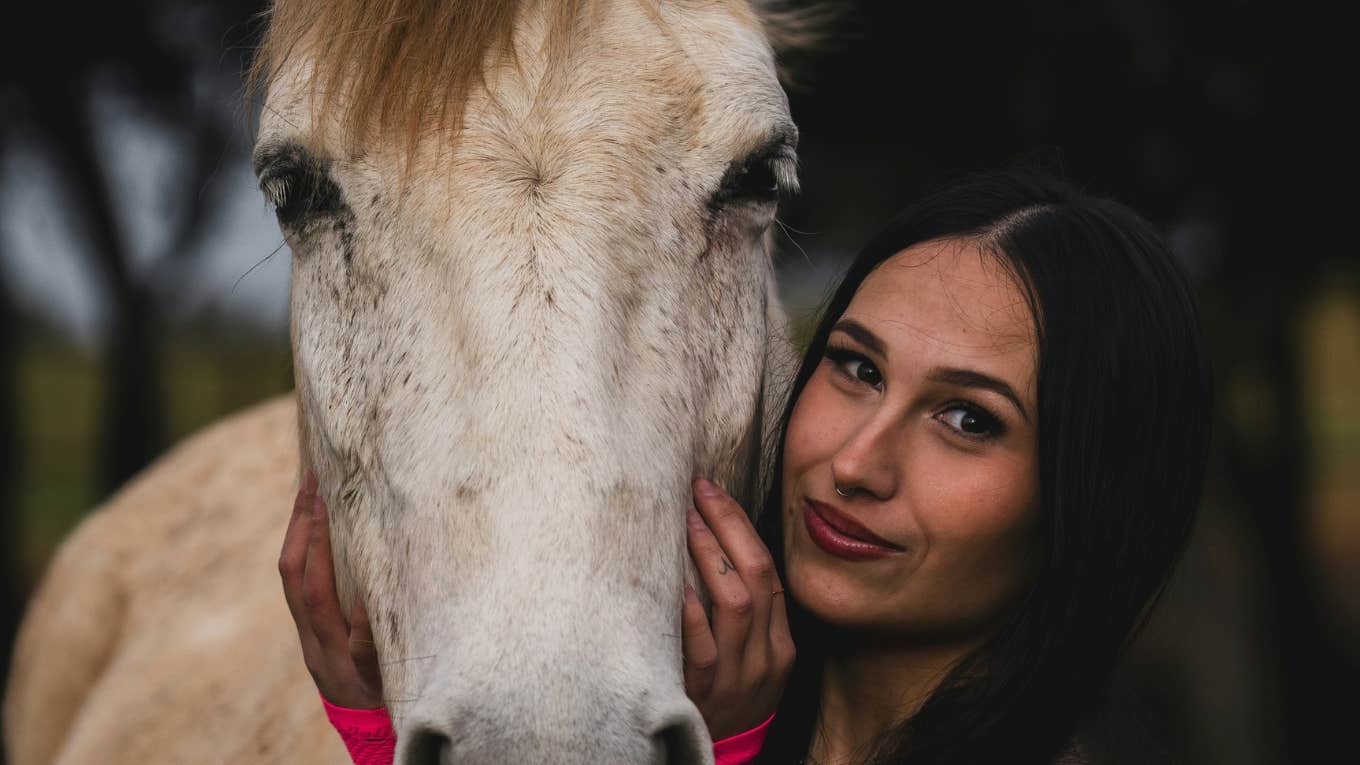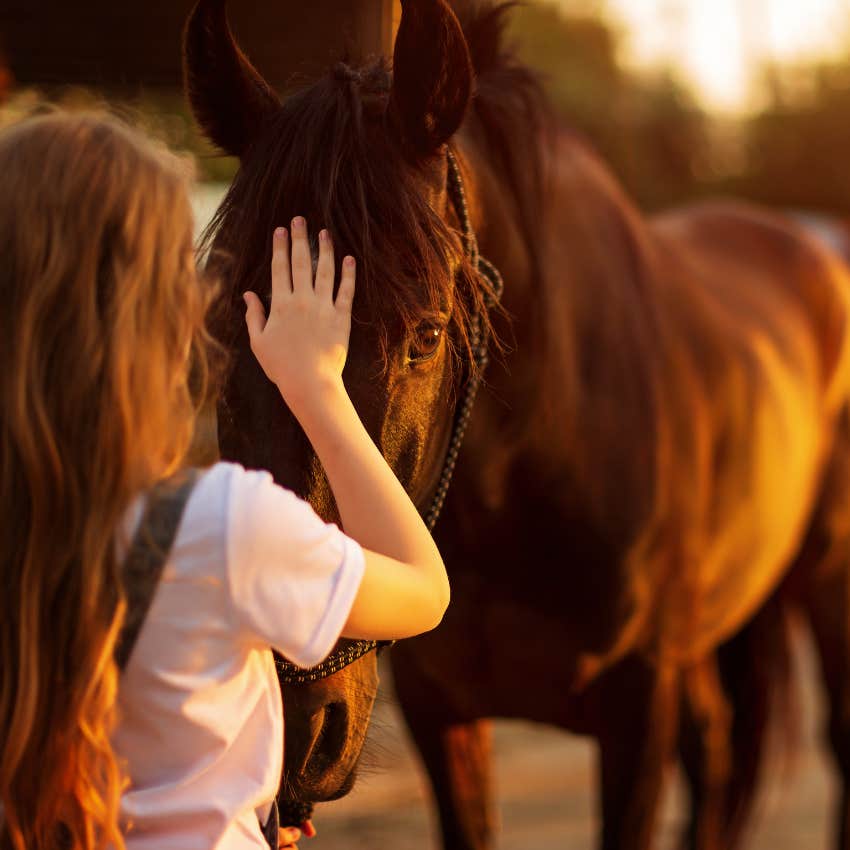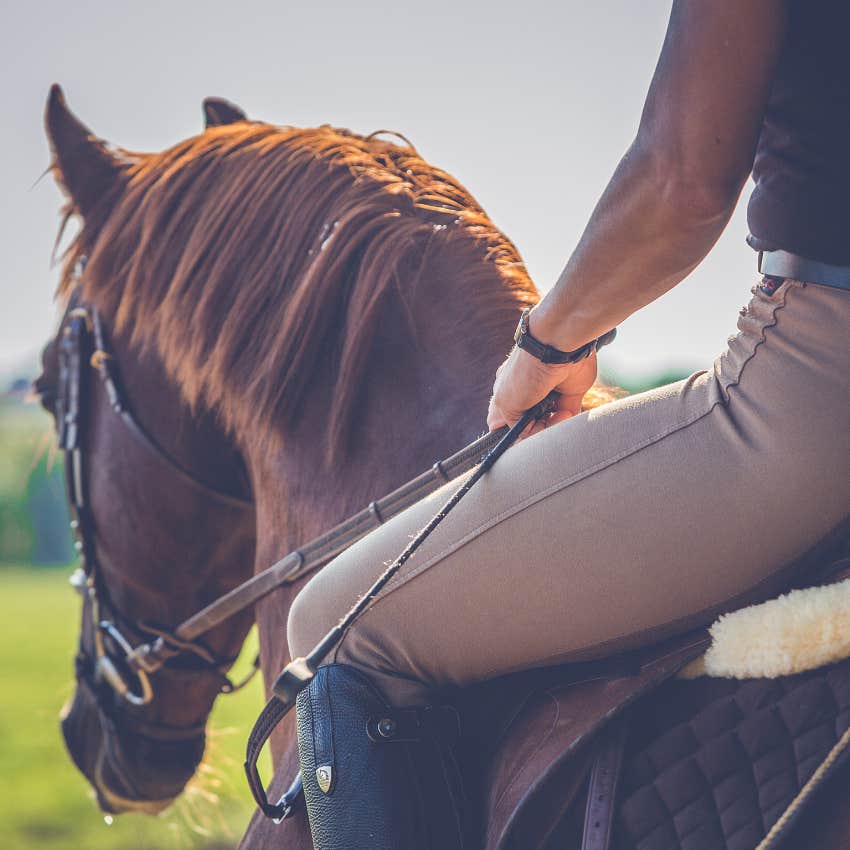My Horse Was The Therapist I Didn't Know I Needed — 'I've Put Him In More Stressful Situations Than I Can Count'
I went looking for calm and found unexpected healing in the heart of my horse.
 Sergio Kian | Unsplash
Sergio Kian | Unsplash Nitro’s neck is arched like a question mark; his ears pricked forward, every muscle braced. A massive flock of grackles lifts from the branches of a cottonwood tree in one singular motion — the synchronous movement of a hundred wings is a muffled explosion.
Nitro flinches. I can feel his nervous system ticking its way up beyond its threshold, dragging mine with it.
“I’m afraid,” he says and swivels one ear toward me, waiting to see what I’ll do.
For years, I ignored fear entirely. I feigned nonchalance when horses dropped out from underneath me, tucking their heads neatly between their front legs and ejecting me into another dimension.
Over the last decade, I’ve put my horse, Nitro, in more stressful situations than I can count.
 Evgeniy pavlovski / Shutterstock
Evgeniy pavlovski / Shutterstock
I pushed him beyond his threshold and then snapped at him in exasperation as he spooked, bucked, or bolted. Stepping out of the saddle was a show of defeat, the mark of a lesser equestrian, one who submits to fear instead of wrangling it to the ground in a tornado of dust.
When Nitro told me he was afraid, I told him to swallow it down and carry on. I left him to deal with his fear alone because I didn’t know how to deal with mine.
My trainer strides across the yard. “What are we working on today?” she asks.
I squint at the front gate. “The road. I hate that road. People never slow down. The other day, someone swerved around us as we were riding across.”
We walk toward it slowly as a semi-truck barrels past the 45 mph speed limit. “I just can’t stop imagining the worst-case scenario,” I tell her. “What if someone doesn’t slow down and we go through the windshield or Nitro slips on the asphalt and we break our legs?”
She walks alongside us, reminding me to breathe. “I just can’t shake the fear,” I tell her. “It won’t go away.”
She looks up at me thoughtfully. “Do you need to ride across?”
“I guess not,” I sigh. “But I feel like I should. Everyone else does.”
I twist my fingers in Nitro’s mane nervously. “I do feel safer walking across,” I admit, “but it feels like a failure, like I’m giving into fear. I need to practice riding across until I feel good about it.”
She brushes a piece of hay from Nitro’s forelock. “But if you don’t feel safe while riding across, what you’re practicing is feeling tense and afraid. We create new neural pathways by pushing a little bit beyond our threshold and then returning to our window of tolerance. If we practice the things that scare us without that pathway to safety, we’re not helping ourselves or our horses respond differently to stress.”
“Don’t worry about what it looks like,” she says. “Focus on what it feels like. What does safety feel like for you?”
I don’t think anyone has ever asked me that question. I look down at Nitro. I don’t think anyone’s ever asked him that, either.
Prey animals don’t have the luxury of second-guessing fear. When fear says jump, they jump. And in some situations, that’s a very good thing.
Nitro sidestepped a charging cow on a narrow trail before my brain registered the word ‘cow.’ When a handful of deer careened out of the brush, Nitro jumped up the embankment and out of their path faster than I could have asked.
A horse’s nervous system is clipped to everything around it. They don’t need their remarkable sense of smell to know you’re afraid; they can feel it.
False bravado doesn’t work on them. That’s predator behavior, and they are attuned to it.
When I climbed back into the saddle after a bad fall, I said I was fine. But Nitro knew better. Emotional incongruence is a sounding bell of alarm for horses. It’s something of a specialty for humans.
When fear knocks on the door of a human heart, we pretend we’re not home, or we drag it in and hold it hostage, pinning it down with our hands over its mouth. And then we never let it go.
Back on the trail, Nitro tucks his hindquarters and clenches his tail as a large coyote slips through the straw-colored cheatgrass.
A flock of geese moves overhead. The air sliding underneath their outstretched wings is a soft sigh on a still evening. When we feel safe, Nitro and I tip our heads to the sky, drinking down the wind, listening to the guttural call of the Double-crested Cormorant, and the screech of a Red-tailed Hawk.
This patch of public land is a sanctuary for them and us. Except when it’s not.
Nitro shifts nervously, his mouth set into a tight line, his eyes wide and worried. I bite my lip, trying to decide what to do.
 gabati / Shutterstock
gabati / Shutterstock
I could force him into flight or fight, risking injury. I could go home, confining safety to a place outside of ourselves, knowing we’ll always be running in search of it. I could dismiss his anxiety with logic, tell him this is a trail we’ve ridden hundreds of times, and insist he’s safe.
Except I don’t feel safe, and neither does he. Years of ignoring his fear and mine have left me braced against my body, sliding shallow breaths into flattened lungs as my heart races. I know what it is to feel unsafe when the world insists you should be fine.
I sit a little more deeply in my saddle as Nitro jigs. My body tenses, remembering the times it’s been hurt. My ego rolls its eyes. “You’ve been riding all your life. You shouldn’t be afraid. Just push him on and ride this out.”
Frankly, I’ve had just about enough of the word ‘should.’ “Don’t worry about what it looks like,” my trainer said. “Focus on what it feels like.”
“This doesn’t feel good,” I think.
I hear her voice in my head. “Then choose something else. What are your options?”
I slide my feet out of the stirrups and swing my leg over the saddle, dropping gently to the ground. I put my hand on my stomach, breathing deeply, trying to shift my nervous system back into its parasympathetic state.
Nitro’s anxiety triggered mine or mine triggered him; either way, we both need a reset. If we carry on like this, we’re only practicing how to be stuck.
I slip the reins over his head. “Here,” I tell him. “I’ll take the lead for a minute; give us a chance to regroup.”
The melodic, drawn-out call of a Red-winged Blackbird moves across the fields. It feels good to stretch my legs. Nitro does an all-body shake and releases a long, sputtering breath. I do the same.
This feels so much better. When I’m not worried about what I should feel, do, or be, I’m free to respond to the present moment. And if it doesn’t feel good, I can choose something else.
Today, the choice that feels best is leading my saddled horse down an old dirt road while a hiker smiles and quips, “You know you’re supposed to ride them, right?”
“That’s an option,” I say, smiling back.
As the sunset stretches our silhouettes into elongated shadows, the scent of alfalfa permeates the air. Nitro gently bumps my elbow with his nose. His eyes are soft, his lips relaxed. We’re okay.
I’m embarrassed to admit it now, but I genuinely thought ignoring fear was the best option. I didn’t realize nervous system regulation was something we could practice as routinely as hindquarter yields or lead changes.
As I hoist myself back into the saddle, I realize what my trainer meant. If we focus on understanding the feeling of safety, it’s easier to find our way back to it no matter what arises. But if we fixate on what we think it should look like, we miss the point.
“What are your options?” my trainer always asks when I get stuck, helping me understand that I have them. Emotional safety is not one thing. It looks a little different every day.
The capacity to work through fear is tied to being heard and having someone validate your experience and emotion instead of dismissing it when it doesn’t match their own.
Sometimes, we feel safe galloping across an open field. Sometimes, we need to pause and regroup. Sometimes, we slowly walk home.
With my horse loose and limber beneath me and the waning sun falling across our faces, safety is the space to work through our fear without judgment or shame. It’s connection and trust. It’s the quiet, undeniable feeling of us.
Nikki Hodgson is a writer, horse girl, and recovering pragmatist who once thought abandoning a dream was practical. She's now making up for lost time—one essay (and crisis) at a time.

